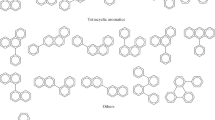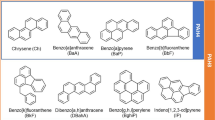Abstract
The monitoring of the content of polycyclic aromatic hydrocarbons (PAHs) is important for evaluating heavy oil products, especially those most likely to cause environmental impacts. In this study, a comparison between samples of heavy petroleum fractions, using different methods, was carried out. The calculation of carbon distribution and polycyclic aromatic contents was compared with other methods using Fourier transform infrared spectroscopy (FTIR). Therefore, it was possible to quickly estimate the aromatic content by the FTIR method, and the results showed consistency with those obtained through traditional methods. A rapid method, using extraction with dimethyl sulfoxide followed by FTIR measurements, was proposed and shown as particularly useful and reliable for a quick quantification of the PAH content, when compared to the traditional IP 346 method. Furthermore, the difference in total aromatic and PAH concentrations may be more clearly established. This rapid method may be used for the evaluation of PAH content in samples obtained from studies for their removal from complex heavy oil fractions.





Similar content being viewed by others
References
Ai-jun, G., Zhi-hui, R., Ling-yan, T., Zong-xian, W., & Ke-qin, L. (2007). Characterization of molecular change of heavy oil under mild thermal processing using FT-IR spectroscopy. Journal of Fuel Chemistry and Technology, 35(2), 169–175.
Andrade-Eiroa, A., Diévart, P., & Dagaut, P. (2010). Improved optimization of polycyclic aromatic hydrocarbons (PAHs) mixtures resolution in reversed-phase high-performance liquid chromatography by using factorial design and response surface methodology. Talanta, 81, 265–274.
ASTM International. (2010). Petroleum products, lubricants and fossil fuels, section 5, American Society for Testing and Materials. Philadelphia: ASTM.
Ballesteros-Gómez, A., Rubio, S., & Pérez-Bendito, D. (2008). Journal of Chromatography A, 1203, 168–176.
Bernabei, M., Redá, R., Galiero, R., & Bocchinfuso, G. (2003). Determination of total and polycyclic aromatic hydrocarbons in aviation jet fuel. Journal of Chromatography A, 985, 197–203.
Bjoerseth, A., & Ramdhal, T. (1985). Handbook of polycyclic aromatic hydrocarbons (Vol. 2). New York: Marcel Dekker.
Choudhary, T. V., & Meier, P. F. (2008). Characterization of heavy petroleum feedstocks. Fuel Processing Technology, 89, 697–703.
Cloarec, O., Gonzalez, C., Touraud, E., & Thomas, O. (2002). Improvement of UV spectrophotometry methodology for the determination of total polycyclic aromatic compounds in contaminated soils. Analytica Chimica Acta, 453, 245–252.
Commission Regulation. (2009). Official Journal of the European Union, N. 552/2009.
Froehner, S., Maceno, M., Da Luz, E. C., Souza, D. B., & Machado, K. S. (2010). Distribution of polycyclic aromatic hydrocarbons in marine sediments and their potential toxic effects. Environmental Monitoring and Assessment, 168, 205–213.
Garcia, M. R., Mirlean, N., Baisch, P. R., & Caramão, E. B. (2010). Assessment of polycyclic aromatic hydrocarbon influx and sediment contamination in an urbanized estuary. Environmental Monitoring and Assessment, 168, 269–276.
Harvey, R. G. (1991). Polycyclic aromatic hydrocarbons: chemistry and carcinogenicity. Cambridge: University Press.
International Agency for Research on Cancer - IARC. (1983). Benzo[a]pyrene, polynuclear aromatic compounds, part 1, chemical, environmental and experimental data (Vol. 32). Lyon: IARC.
IP 346. (1993). Polycyclic aromatics in petroleum fractions by dimethyl sulphoxide - refractive index method, test method designation IP 346/80. In: IP Standards for Petroleum and its Products. Part I: Methods of Analysis and Testing. Vol. 2. 3rd Annual Edition. London: Institute of Petroleum
Jinno, K., Miyashita, Y., Sasaki, S., Fetzer, J. C., & Biggs, W. R. (1991). Separation of large polycyclic aromatic hydrocarbons in particulate matter by liquid chromatography. Environmental Monitoring and Assessment, 19, 13–25.
Lee, M. L., Novotny, M. V., & Bartle, K. D. (1981). Analytical chemistry of polycyclic aromatic compounds. New York: Academic Press.
Liu, C. G., Que, G. H., Chen, Y. Z., & Liang, W. J. (1987). Two estimating methods of carbon aromaticity f A from vacuum residue. Petroleum Processing, 18(12), 53–56.
Mackerer, C. R., Griffis, L. C., Grabowski, J. S., & Reitman, F. A. (2003). Petroleum mineral oil refining and evaluation of cancer hazard. Applied Occupational and Environmental Hygiene, 18, 890–901.
Mehrkesh, A. H., Hajimirzaee, S., & Hatamipour, M. S. (2010). A generalized correlation for characterization of lubricating base-oils from their viscosities. Chinese Journal of Chemical Engineering, 18(4), 642–647.
Meyers, R. A. (2003). Handbook of petroleum refining processes (3rd ed.). New York: McGraw-Hill.
Olajire, A. A., & Oderinde, R. A. (1998). Study of aromatic hydrocarbons in heavy residual oils by a combination of spectroscopic analytical techniques. Journal of African Earth Sciences, 27, 165–174.
Paproski, R. E., Cooley, J., & Lucy, C. A. (2005). Comparison of titania, zirconia, and silica stationary phases for separating diesel fuels according to hydrocarbon group-type by supercritical fluid chromatography. Journal of Chromatography A, 1095, 156–163.
Pasadakis, N., Gaganis, V., & Varotsis, N. (2001). Accurate determination of aromatic groups in heavy petroleum fractions using HPLC-UV-DAD. Fuel, 80, 147–153.
Rao, P. S., Faiyaz, M., Ansari Pipalatkar, P., Kumar, A., Nema, P., & Devotta, S. (2008). Measurement of particulate phase polycyclic aromatic hydrocarbon (PAHs) around a petroleum refinery. Environmental Monitoring and Assessment, 137, 387–392.
Silverstein, R. M., Webster, F. X., & Kiemle, D. (2005). Spectrometric identification of organic compounds (7th ed.). New York: John Wiley & Sons, Inc.
Speight, J. G. (2001). Handbook of petroleum analysis. New York: Marcel Dekker.
USEPA. (2006). EPA Science Policy Council Peer Review Handbook, 3rd ed., EPA/100/B-06/002. www.epa.gov/peerreview, accessed 10 november 2014.
Vo-Dinh, T., Fetzer, J., & Campiglia, A. D. (1998). Monitoring and characterization of polyaromatic compounds in the environment. Talanta, 47, 943–969.
Zerlia, T., Pinelli, G., Zaghi, M., & Frignani, S. (1990). U.V. spectrometry as a tool for rapid screening of petroleum products. Fuel, 69(11), 1381–1385.
Acknowledgments
The authors acknowledge financial support from FUNCAP and Petrobras.
Author information
Authors and Affiliations
Corresponding author
Rights and permissions
About this article
Cite this article
Luna, F.M.T., Pontes Filho, A.A., Trindade, E.D. et al. Rapid assessment of total and polycyclic aromatic contents in heavy oils. Environ Monit Assess 188, 215 (2016). https://doi.org/10.1007/s10661-016-5213-7
Received:
Accepted:
Published:
DOI: https://doi.org/10.1007/s10661-016-5213-7




